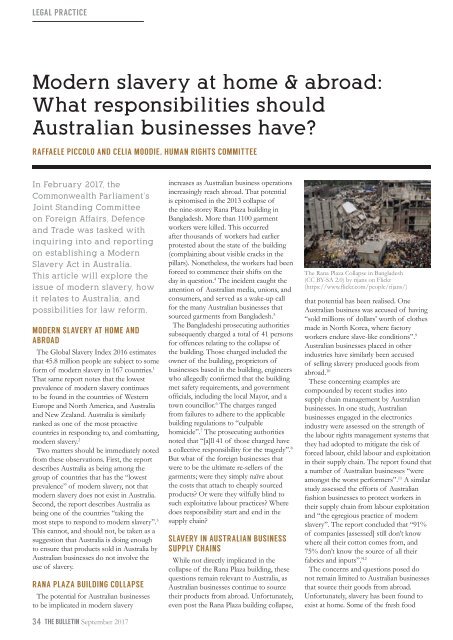LSB September 2017
Create successful ePaper yourself
Turn your PDF publications into a flip-book with our unique Google optimized e-Paper software.
LEGAL PRACTICE<br />
Modern slavery at home & abroad:<br />
What responsibilities should<br />
Australian businesses have?<br />
RAFFAELE PICCOLO AND CELIA MOODIE, HUMAN RIGHTS COMMITTEE<br />
In February <strong>2017</strong>, the<br />
Commonwealth Parliament’s<br />
Joint Standing Committee<br />
on Foreign Affairs, Defence<br />
and Trade was tasked with<br />
inquiring into and reporting<br />
on establishing a Modern<br />
Slavery Act in Australia.<br />
This article will explore the<br />
issue of modern slavery, how<br />
it relates to Australia, and<br />
possibilities for law reform.<br />
MODERN SLAVERY AT HOME AND<br />
ABROAD<br />
The Global Slavery Index 2016 estimates<br />
that 45.8 million people are subject to some<br />
form of modern slavery in 167 countries. 1<br />
That same report notes that the lowest<br />
prevalence of modern slavery continues<br />
to be found in the countries of Western<br />
Europe and North America, and Australia<br />
and New Zealand. Australia is similarly<br />
ranked as one of the most proactive<br />
countries in responding to, and combatting,<br />
modern slavery. 2<br />
Two matters should be immediately noted<br />
from these observations. First, the report<br />
describes Australia as being among the<br />
group of countries that has the “lowest<br />
prevalence” of modern slavery, not that<br />
modern slavery does not exist in Australia.<br />
Second, the report describes Australia as<br />
being one of the countries “taking the<br />
most steps to respond to modern slavery”. 3<br />
This cannot, and should not, be taken as a<br />
suggestion that Australia is doing enough<br />
to ensure that products sold in Australia by<br />
Australian businesses do not involve the<br />
use of slavery.<br />
RANA PLAZA BUILDING COLLAPSE<br />
The potential for Australian businesses<br />
to be implicated in modern slavery<br />
34 THE BULLETIN <strong>September</strong> <strong>2017</strong><br />
increases as Australian business operations<br />
increasingly reach abroad. That potential<br />
is epitomised in the 2013 collapse of<br />
the nine-storey Rana Plaza building in<br />
Bangladesh. More than 1100 garment<br />
workers were killed. This occurred<br />
after thousands of workers had earlier<br />
protested about the state of the building<br />
(complaining about visible cracks in the<br />
pillars). Nonetheless, the workers had been<br />
forced to commence their shifts on the<br />
day in question. 4 The incident caught the<br />
attention of Australian media, unions, and<br />
consumers, and served as a wake-up call<br />
for the many Australian businesses that<br />
sourced garments from Bangladesh. 5<br />
The Bangladeshi prosecuting authorities<br />
subsequently charged a total of 41 persons<br />
for offences relating to the collapse of<br />
the building. Those charged included the<br />
owner of the building, proprietors of<br />
businesses based in the building, engineers<br />
who allegedly confirmed that the building<br />
met safety requirements, and government<br />
officials, including the local Mayor, and a<br />
town councillor. 6 The charges ranged<br />
from failures to adhere to the applicable<br />
building regulations to “culpable<br />
homicide”. 7 The prosecuting authorities<br />
noted that “[a]ll 41 of those charged have<br />
a collective responsibility for the tragedy”. 8<br />
But what of the foreign businesses that<br />
were to be the ultimate re-sellers of the<br />
garments; were they simply naïve about<br />
the costs that attach to cheaply sourced<br />
products? Or were they wilfully blind to<br />
such exploitative labour practices? Where<br />
does responsibility start and end in the<br />
supply chain?<br />
SLAVERY IN AUSTRALIAN BUSINESS<br />
SUPPLY CHAINS<br />
While not directly implicated in the<br />
collapse of the Rana Plaza building, these<br />
questions remain relevant to Australia, as<br />
Australian businesses continue to source<br />
their products from abroad. Unfortunately,<br />
even post the Rana Plaza building collapse,<br />
The Rana Plaza Collapse in Bangladesh<br />
(CC BY-SA 2.0) by rijans on Flickr<br />
(https://www.flickr.com/people/rijans/)<br />
that potential has been realised. One<br />
Australian business was accused of having<br />
“sold millions of dollars’ worth of clothes<br />
made in North Korea, where factory<br />
workers endure slave-like conditions”. 9<br />
Australian businesses placed in other<br />
industries have similarly been accused<br />
of selling slavery produced goods from<br />
abroad. 10<br />
These concerning examples are<br />
compounded by recent studies into<br />
supply chain management by Australian<br />
businesses. In one study, Australian<br />
businesses engaged in the electronics<br />
industry were assessed on the strength of<br />
the labour rights management systems that<br />
they had adopted to mitigate the risk of<br />
forced labour, child labour and exploitation<br />
in their supply chain. The report found that<br />
a number of Australian businesses “were<br />
amongst the worst performers”. 11 A similar<br />
study assessed the efforts of Australian<br />
fashion businesses to protect workers in<br />
their supply chain from labour exploitation<br />
and “the egregious practice of modern<br />
slavery”. The report concluded that “91%<br />
of companies [assessed] still don’t know<br />
where all their cotton comes from, and<br />
75% don’t know the source of all their<br />
fabrics and inputs”.’ 12<br />
The concerns and questions posed do<br />
not remain limited to Australian businesses<br />
that source their goods from abroad.<br />
Unfortunately, slavery has been found to<br />
exist at home. Some of the fresh food


















